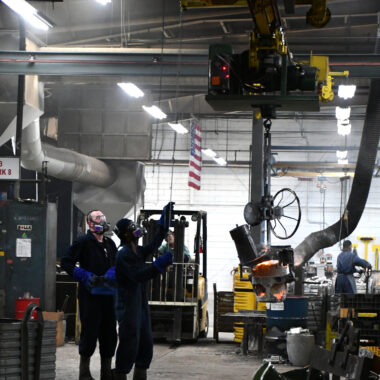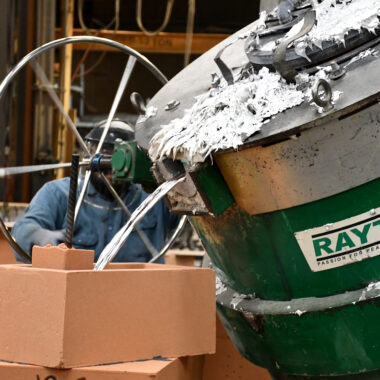Unveiling the Different Kinds Of Aluminum Casting Processes for Accuracy Outcomes
From die spreading to sand spreading, financial investment spreading, long-term mold and mildew spreading, and centrifugal casting, each approach brings its own set of advantages and ins and outs to the table. By discovering the distinctive characteristics of each spreading method, a deeper insight into the globe of light weight aluminum spreading can be obtained, dropping light on the ideal method for accomplishing precision outcomes in different applications.
Die Casting Refine
This procedure entails requiring molten steel right into a steel mold tooth cavity under high pressure. The mold and mildew, also recognized as a die, is usually made in 2 parts: the cover pass away fifty percent and the ejector die fifty percent.
One of the key advantages of die casting is its capacity to produce parts with thin walls, elaborate information, and smooth surfaces. This makes it a favored choice for sectors such as automobile, aerospace, and electronics where intricate steel components are called for. Additionally, die casting deals superb dimensional precision, enabling minimal post-processing demands.
In addition, die casting can be categorized into warm chamber and cool chamber pass away casting procedures. In warm chamber pass away casting, the molten steel is consisted of in a furnace while in chilly chamber pass away spreading, the molten metal is ladled right into the cold chamber for each shot. aluminum casting. Each technique has its own set of benefits and is chosen based on the certain requirements of the task
Sand Spreading Approach
Making use of a centuries-old method, the sand casting approach is a commonly utilized process in the production market for developing steel parts. This method entails developing a mold made from compacted sand right into which molten steel is poured, permitting it to take the shape and solidify of the mold and mildew cavity. Sand spreading is valued for its convenience, as it can produce a large range of complex sizes and shapes, making it suitable for numerous markets such as vehicle, aerospace, and art shops.
In spite of its lengthy history, modern-day innovations in sand spreading techniques, such as the use of computer system simulations for mold and mildew style and 3D printing for producing elaborate patterns, have actually better enhanced the accuracy and efficiency of the process. In general, the sand casting technique stays a popular option for makers looking for a cost-effective and reliable means to produce top quality metal components.
Investment Casting Strategy

This strategy is favored for its ability to generate complicated forms with high accuracy and great surface area finishes. Industries such as aerospace, auto, and precious jewelry rely on financial investment casting for components that need tight tolerances and intricate information. The process enables for cost-effective production of little to medium-sized components in numerous products, making it a versatile selection for producers looking for accuracy outcomes.
Irreversible Mold And Mildew Spreading
With a focus on developing metal components with a recyclable mold, Permanent Mold and mildew Casting uses an alternate method to the elaborate precision of investment casting. aluminum casting. This approach, additionally recognized as gravity die spreading, entails the use of a permanent metallic mold and mildew normally made from steel or cast iron. The mold is preheated prior to the molten steel is poured right into it, permitting faster solidification contrasted to sand spreading
Long-term Mold Casting enables the manufacturing of high-quality, dimensionally exact parts with a great surface area finish. By utilizing a recyclable mold and mildew, makers can achieve cost savings with time as the mold and mildew can be used numerous times without substantial wear and tear. This procedure is suitable for high-volume production runs where uniformity and performance are essential.
One of the crucial benefits of Irreversible Mold and mildew Casting is its ability to produce complex shapes and complex layouts with convenience. aluminum casting. The approach is extensively utilized in the automotive, aerospace, and electronics sectors for producing elements such as engine components, warm sinks, and structural aspects

Centrifugal Casting Method
The Centrifugal Spreading Technique is a method that includes rotating a mold and mildew at broadband while putting liquified metal right into it. This process makes use of centrifugal force to disperse the liquified steel evenly along the wall surfaces of the have a peek at this website mold, leading to a high-grade, dense spreading. The centrifugal pressure pushes contaminations and gases towards the inner size of the casting, causing a cleaner last product with boosted mechanical residential properties.
One of the essential benefits of centrifugal casting is the capability to generate round or disk-shaped components with a fine-grained framework that improves the mechanical residential or commercial properties of the spreading. This technique is specifically appropriate for producing balanced parts such as pipes, rings, and tubes. Additionally, centrifugal casting uses the benefit of being a cost-effective process with fairly low tooling expenses compared to various other casting approaches.
Verdict
In final thought, article source recognizing the various sorts of light weight aluminum spreading procedures is critical for achieving precise lead to manufacturing. Each approach has its very own benefits and constraints, making it important to select the most suitable procedure based on the particular requirements of the project. Whether it is die casting, sand casting, financial investment spreading, irreversible mold and mildew spreading, or centrifugal spreading, selecting the ideal method can cause high-grade and cost-efficient manufacturing results.
From die casting to sand casting, financial investment spreading, long-term mold spreading, and centrifugal casting, each method brings its own collection of benefits and ins and outs to the table. By discovering the distinct characteristics of each spreading technique, a deeper understanding right into the globe of aluminum casting can be obtained, dropping light on the optimal strategy for accomplishing precision outcomes in various applications.
In hot chamber die casting, the liquified steel is contained in a heater while in chilly chamber die spreading, the molten steel is ladled into the cool chamber for each shot.With an emphasis on creating steel elements via a recyclable mold, Irreversible Mold Spreading provides a different technique to the intricate accuracy of investment spreading. Whether it is die casting, sand spreading, investment spreading, permanent mold and mildew spreading, or centrifugal casting, picking the ideal method can lead to cost-effective and high-grade production results.